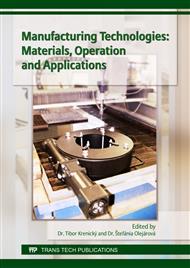p.88
p.96
p.107
p.119
p.127
p.136
p.142
p.149
p.155
Assessment of Suitability of the Design of Gating System with the Use of Simulation Software
Abstract:
The quality of thin wall castings produced by metal die-casting depends on the coherence and consistency of various aspects influencing the process of casting cycle. The qualitative properties of castings should already be considered in the design phase of construction of the gating system. The simulation software is an effective facility for the initial revealing of defects of the design phase. The assessment of casting cycle by the means of simulation predicts an incidence of defects of the casting core in the design phase and therefore reduces both the incidence of defects in the production and the costs while the production efficiency is increased. The article deals with the assessment of the design of the gating system for a particular casting type. The filling of mould cavity, casting solidification and time course of temperature changes occurring in the selected locations of gating system were defined as parameters indicating the assumptions of design accuracy. Simulation tests were carried out in the NovaFlow&Solid program. The tests resulted in a conclusion evaluating and describing the adequacy of structural design of the gating system.
Info:
Periodical:
Pages:
136-141
Citation:
Online since:
September 2017
Authors:
Keywords:
Price:
Сopyright:
© 2017 Trans Tech Publications Ltd. All Rights Reserved
Share:
Citation:


